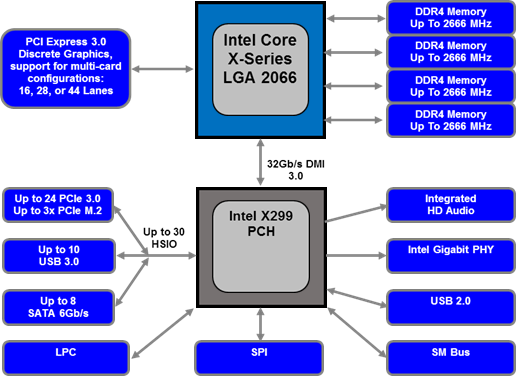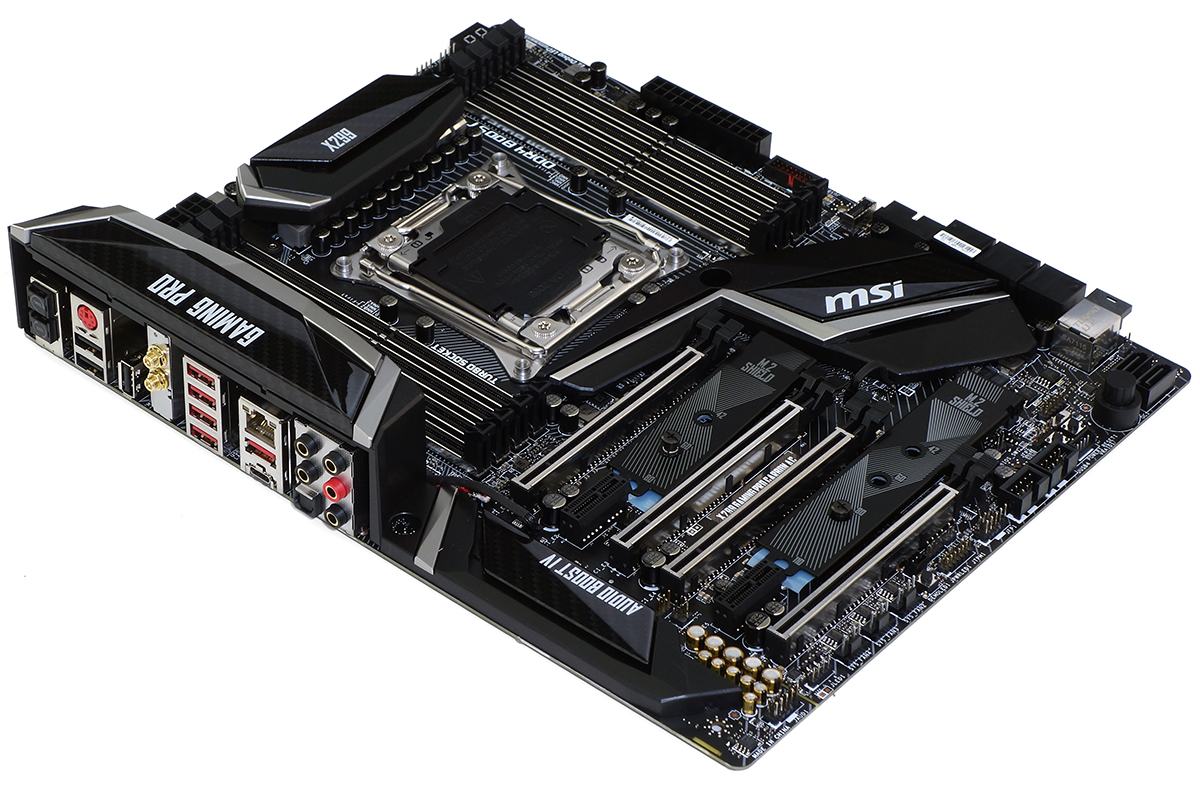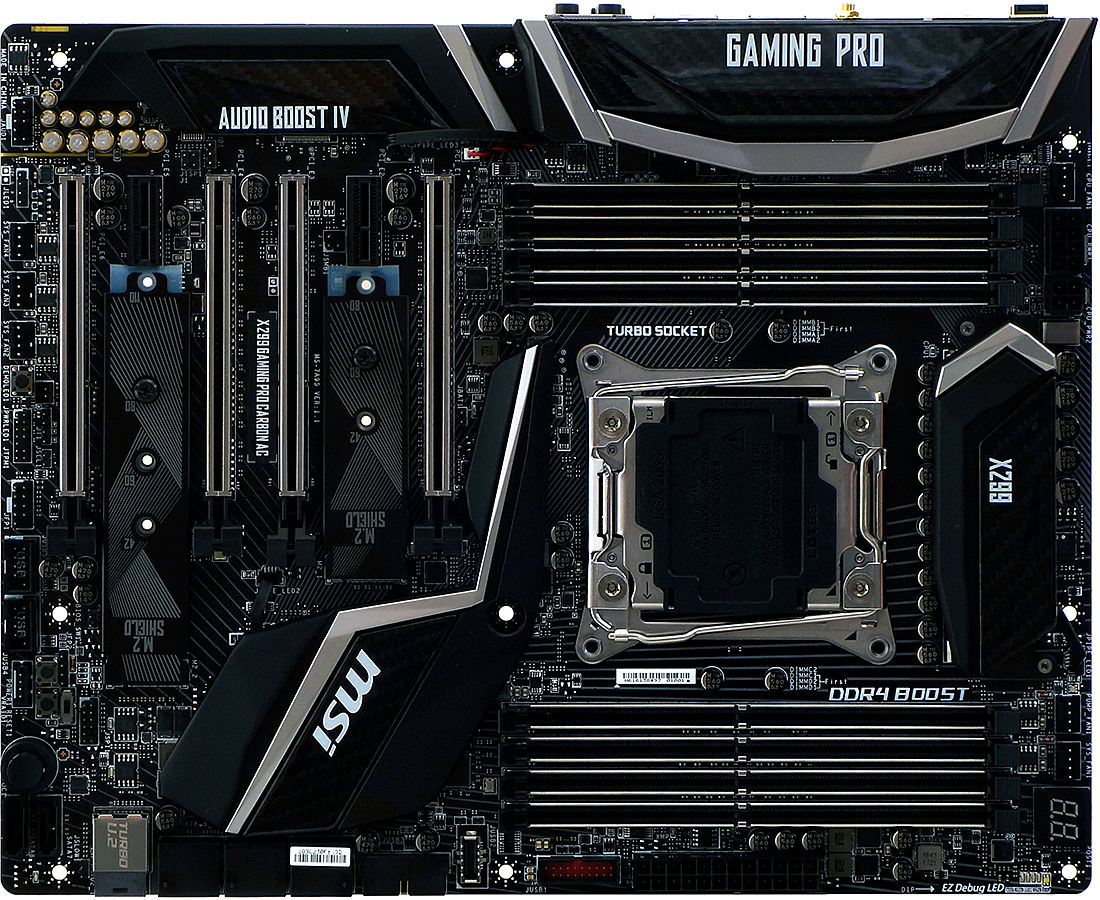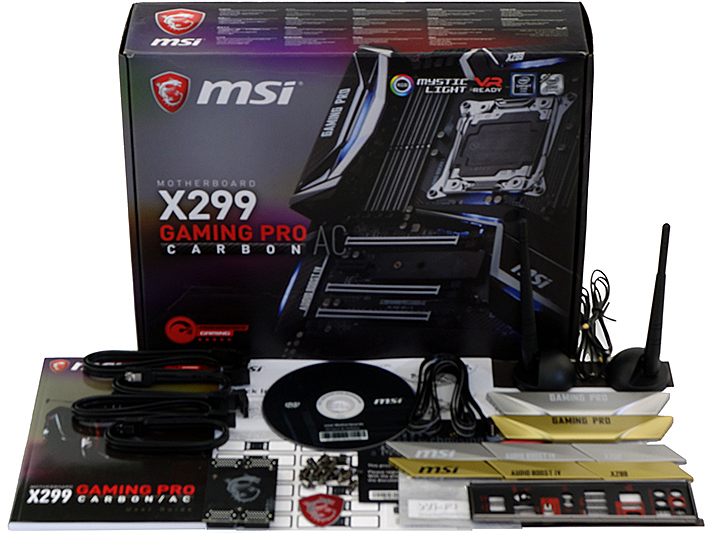Early Verdict
The MSI X299 Gaming Pro Carbon AC is, like our comparison board, slightly too new and . . . evolving. We'll continue to examine its performance as we visit other X299 products. However, we can say that the X299 Gaming Pro Carbon AC comes in at a more affordable price (so far) for this category, even if it's lacking some of the higher end features.
Pros
- +
Fewer shared resources
- +
Supports 3-way SLI on 28-lane CPUs
- +
Good memory overclocking
- +
High-end 802.11AC controller in addition to Gigabit Ethernet
- +
Moderate price
Cons
- -
Mediocre CPU Overclocking
- -
Poor efficiency
- -
Reduced resource sharing is due to reduced feature set
Why you can trust Tom's Hardware
Features & Specifications
Intel’s new X299 platform replicates what we’ve seen in its mainstream desktop advancements over the past two years, and the most amazing part of that is the age of the X99 it replaces. HEDT (High-End Desktop) users had to wait all this time for a faster DMI interface to connect various devices through the chipset to the CPU, while suffering with an old one that limited all 10 of their SATA SSDs and any attached network and USB controllers to a combined total of 20Gb/s. At 32Gb/s, even the latest iteration of Thunderbolt was too fast for the X99. So, what does all of this newfangled, mainstream tech add to the high end?
Thanks to the more recent DMI 3.0 interface, the chipset link is exactly as fast as a Thunderbolt 3 controller. Add one and fill it with multiple devices, and you’re still left with your SATA drives fighting for bandwidth. I say that in jest, knowing that most boards will get their M.2, U.2, network, and Thunderbolt 3 bandwidth over that DMI 3.0 x4 link, so that overloading any of those interfaces could make it feel like you’re still stuck on SATA. Of course, the LGA 2066 platform still has the same workaround as the LGA 2011 and 2011-v3: The CPU has up to 44 lanes. Unfortunately, Intel saw fit to add a basic dual-channel-memory CPU with 16 PCI lanes to the mix, in the form of Kaby Lake-X. For those who thought that 28-lane CPUs were stuffing up the X99, Intel decided to double down on those difficulties.
Fortunately, the CPUs are a little faster, for the most part, and the chipset’s link is twice as fast as the previous version, even if twice as fast isn’t enough. You’ve probably read the reviews that show situations where the new cores fall behind Broadwell-E, and I’ll just leave it to developers to work those pieces out as I focus on what motherboard manufacturers have accomplished in their efforts to help Skylake-X motherboards work around Kaby Lake-X restrictions.
Specifications
We're running back-to-back reviews of MSI's X299 Gaming Pro Carbon AC and the Asus Prime X299-Deluxe, but we're presenting the results of both boards in both reviews, so this is a bit of a spoiler alert. The Asus motherboard review will run later today. But let's start with MSI.
Features
The X299 Gaming Pro Carbon AC carries the tradition of MSI's Pro Carbon series by having only a few more than the “belly button” high end features of USB 3.1 Gen 2 and, when it’s in the name, WiFi. The X299 version gets two M.2 slots, because nearly every other enthusiast motherboard has at least that many, plus a U.2 port, a Port 80 diagnostics display, and on-board power and reset buttons to satisfy similar expectations of the enthusiast community. The few additions are the BIOS Flashback+ feature for programing a new BIOS when the CPU model you ordered is newer than the board you received, a Demo button for the LED lighting, and a “Game Boost” knob that selects between 11 overclocking profiles.
That’s not to say we’d expect the Gaming Pro Carbon AC to be priced near the bottom of the enthusiast market though, as MSI does a few things to enhance the “regular” features, such as reinforcing the DIMMs and x16 slots with stainless steel shells, gold plating its audio jacks, adding a revised USB 3.1 Gen2 front-panel connector to the improved ASM3142 USB 3.1 controller, tossing in a couple decorative covers for M.2 drives, and adding gold and silver replacements for its Carbon accent panels. While some of these could be done for spare change, they add to the expense of a high-end Intel 8265 Wi-Fi/Bluetooth module and a special ASIC that enables Flashback+.
Not that most users would want to replace the carbon fiber look with metallic silver or gold paint, but those who do will save some effort and retain MSI’s logos. Scanning around the board for fitment issues, the only conflict between slots and on-board connectors are the bottom SATA ports, which are around 8.5” forward of the rear edge, and could impact certain 3-way SLI configurations, depending on the size and shape of the card’s heat sink. The Game Boost knob also has the potential of getting in the way with its 5/8” height at an 8” distance from the rear edge.
Get Tom's Hardware's best news and in-depth reviews, straight to your inbox.
The bottom SATA ports might not be a problem if you plan to add a U.2 drive, since it consumes the same four HSIO resources as SATA ports 5-8. Of course you could add a U.2 adapter to one of the M.2 slots, unless you think of U.2 as existing because motherboard designers run out of space for M.2 slots. And, if you need more U.2 or M.2 drives, that second x16-length slot isn’t designed with graphics cards in mind anyway: Its four lanes are perfect for hosting an M.2 drive, U.2 adapter, or even some other card-mounted drive controller. If you’re now confused about the board’s 3-way SLI capability, it comes via the first, third, and fourth x16-length slots. It goes without saying that CrossFire configurations are not restricted in these ways, but we’ll say it anyway.
Here’s where things get weird: Per MSI documents, the bottom PCIe slot gets its eight lanes from the top slot, and the third slot is locked into eight pathways…unless you’re using a Kaby Lake-X (16-lane) processor. Then, and only then, the second slot can steal four lanes from the third whenever a card is detected there. And Kaby Lake-X also gives up any connectivity whatsoever to the bottom slot. Kaby Lake-X also disables half the DIMMs: The more we consider the limitations of bottom-tier LGA 2066 processors (Core i7-7740X and Core i5-7640X), the more apt we are to recommend Kaby Lake customers stick to less-expensive Z270 motherboards.
The X299 Gaming Pro Carbon AC installation kit includes four SATA cables, a driver and applications disc, an RGB extension cable, two magnetic-base Wi-Fi antennas, an HB-style SLI bridge, several standoffs for mounting 3D-printable accessory covers, a case badge, gold and silver replacements for the carbon-look accents, an I/O shield, full printed documentation, and a sheet of adhesive cable tags.
MORE: Best Motherboards
MORE: How To Choose A Motherboard
MORE: All Motherboard Content
-
JamesSneed Damn this board is pulling 77 more watts than the ASUS board in the Prime95 small FTT test. Things are certainly not sorted out yet on the x299 platform.Reply -
JamesSneed Why are none of the games the same games "you" tested with the 7900x review yesterday? I get not including Ryzen here but gosh could "you" at least make things standard so comparisons can be made to the 7900x review yesterday which had lots of data points for Ryzen with the latest fixes. Thomas, Paul and you should talk every now and then.Reply -
Crashman Reply
I believe we'll find that the problem is with the firmware we were using.19841125 said:Damn this board is pulling 77 more watts than the ASUS board in the Prime95 small FTT test. Things are certainly not sorted out yet on the x299 platform.
The CPU editor is a little fussier about showing certain performance details of the CPU. We picked the motherboard test suite during last fall's software update while leaning a little more heavily towards production volume (more reviews).19841143 said:Why are none of the games the same games "you" tested with the 7900x review yesterday? I get not including Ryzen here but gosh could "you" at least make things standard so comparisons can be made to the 7900x review yesterday which had lots of data points for Ryzen with the latest fixes. Thomas, Paul and you should talk every now and then.
-
mojolou I guess the power consumption difference between these 2 boards is because of different package TDP. If you check the package TDP with Intel XTU, I guess the Asus' package TDP is something like 17x W, while MSI 23x W. When running Prime95 Small FFTs, something limits 7900X from drawing expected power on Asus board.Reply -
Crashman Reply
You mean, working correctly stops it from drawing the expected power? I mean, Intel says 140W, the board, memory, and idle components draw around 60W in this test.19843656 said:I guess the power consumption difference between these 2 boards is because of different package TDP. If you check the package TDP with Intel XTU, I guess the Asus' package TDP is something like 17x W, while MSI 23x W. When running Prime95 Small FFTs, something limits 7900X from drawing expected power on Asus board.
-
JamesSneed Reply19842954 said:Only $ 2.000 for a new machine (i7-7800X)! For games!
I realize you were being sarcastic but If you have been around PC's 20+ years this is nothing. I recall paying over 2K for a PC that was pretty middle of the road non-gaming machine back around 1993-94. A high end PC back then would easily top 3K and that is not adjusting for inflation. Oh and memory was about $400 for 4MB(Not GB) sticks back around 1995.
The pricing now a days is pretty nice you can go really high end and stay under 3K.
Found this from 1993 add:
Dell was selling a top-of-the-line 486 with a 66MHz processor, eight megabytes of RAM and a 320-megabyte hard drive for $4,400. -
FrozenGerbil I placed an order for the MSI X299 Gaming Pro Carbon and the i9-7900X at Newegg, which also offered $50 off for the combo deal, along with a free Corsair AIO cooler included with the motherboard. After thoroughly researching all the available X299 motherboards currently available, MSI's X299 Pro Carbon hits the "sweet spot" for me and my intended use - 3D modeling and rendering, 4K video editing, and processing thousands of digital photos, including Adobe and HDR photo processing. I will be using this setup with a GTX 1050 Ti that I already have. My gaming rig stays the same - an MSI Z270 XPower Gaming Titanium, i7-7700K, and two MSI GTX 1080 Ti Gaming X GPUs. Yes, the Pro Carbon draws more power and runs warmer, but beats the more expensive Asus and Gigabyte X299 motherboards in numerous reviews that I have read.Reply
For anyone who thinks that $1000 is expensive for a 10-core 20-thread CPU, I grew up writing some BASIC programs on a Commodore 64. I worked part-time at IBM-Austin, helping IBM to build the IBM PC/XT and PC/AT while attending college at UT-Austin at the same time that Michael Dell was building and selling his PC clones from his UT-Austin dorm room. I used my very generous 50%-off IBM employee discount to buy a fully-loaded IBM PC/AT in 1985, which was the most powerful PC when it was initially released with its Intel 80286 processor and 640-KB of memory. The IBM prices for my fully-loaded PC/AT? $6400, including an enhanced graphics monitor and two dot matrix printers. I paid $3200 after IBM discount. The average smartphone now has more computing power than that $6400 PC that I bought in 1985.
For the AMD zealots who say that Threadripper will rip the threads off the i9-7900X, you need to know about the history of Intel vs. AMD since the 1980s. Intel is purposely not releasing the rest of their i9 CPUs sooner because they will wait to see what Threadripper has to offer and then adjust their own i9 CPUs to outflank and leap past Threadripper. Both Intel and Nvidia have been outflanking AMD, both on technical merits and marketing leverage, for decades now. When I was working at IBM during the mid-1980s, IBM hired some of the former AMD engineers and technicians when AMD broke their no-layoffs policy in 1984. And ever since then, AMD has had mass-layoffs every 3 to 5 years because they cannot sustain competition with either Intel or Nvidia. -
JamesSneed We shall see FrozenGerbil, Intel has some serious heat issues to overcome with the 12-18 core parts unless they pull the frequencies back a lot. Do I think Intel will hit back, sure and hard, what I'm not sure about if it will be Skylake-x like you suggested or a generation after. Speaking of IBM, Global Foundries bought out IBM's microprocessor division 2 years ago so AMD will be getting 7nm process node in 18 months to 2 years using IBM engineers and patents. That should be a game changer since AMD up until just now has always had a big process disadvantage versus Intel.Reply




